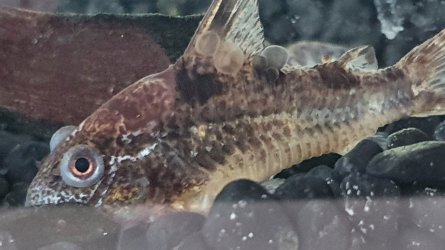BrendanL
New Member
Several weeks ago I introduced some new driftwood from the beach to my 180L tank. I had thought suitable preparation of the wood took place and there were no issues for a few weeks.
More recently, I changed my pebbles to Aqua One black silica sand (a fine gravel). I did this in stages, didn’t change any other water/filter material etc and have even retained some of the old pebbles in some breathable nylon bags underneath the silica. There didn’t appear to be any ‘new tank’ issues as a result of this activity. I am running a UV Filter as well. The Cory’s and the bristle nose appeared OK with the new base, but yes, they were both on my mind during planning and transition.
A few days ago the bristlenose died, with no external signs. TBH, there were no internal signs of gravel – I just needed to check.
Then one of my smaller Cory’s went quiet and developed some reddening under a fin. I isolated him initially in a floating breeder. Then a larger Cory began going quiet. I moved all Cory’s (two larger, three smaller) to a separate tank. Shortly after, the large bronze just died – he wasn’t the same one that initially went quiet. No external signs (I didn’t open him up this time).
While the pebble to gravel transition was the most recent and could seem as a potential issue, it was too much of a coincidence for me that they would all go downhill so fast?
My second thought was on the driftwood. Was it still leaching out salt? There have been no issues with ‘regular’ fish in the main tank - just the Corys and the bristelnose. I’ve done a number of partial water changes in both the main and isolated tank over the last couple of days to hopefully dilute any salt if that was the issue. I have also removed the driftwood.
The Corys in the isolated tank do seem to be more active now, so perhaps the water changes and reducing any possible salt is bringing them back to health?? Time may need to tell on this.
However, on the larger Cory, these nodules are present. I have not seen them before. Are the nodules parasitic or cysts? And what can I do about them?
Also, his eyes are possibly of concern too? No other fish seem to have this
More recently, I changed my pebbles to Aqua One black silica sand (a fine gravel). I did this in stages, didn’t change any other water/filter material etc and have even retained some of the old pebbles in some breathable nylon bags underneath the silica. There didn’t appear to be any ‘new tank’ issues as a result of this activity. I am running a UV Filter as well. The Cory’s and the bristle nose appeared OK with the new base, but yes, they were both on my mind during planning and transition.
A few days ago the bristlenose died, with no external signs. TBH, there were no internal signs of gravel – I just needed to check.
Then one of my smaller Cory’s went quiet and developed some reddening under a fin. I isolated him initially in a floating breeder. Then a larger Cory began going quiet. I moved all Cory’s (two larger, three smaller) to a separate tank. Shortly after, the large bronze just died – he wasn’t the same one that initially went quiet. No external signs (I didn’t open him up this time).
While the pebble to gravel transition was the most recent and could seem as a potential issue, it was too much of a coincidence for me that they would all go downhill so fast?
My second thought was on the driftwood. Was it still leaching out salt? There have been no issues with ‘regular’ fish in the main tank - just the Corys and the bristelnose. I’ve done a number of partial water changes in both the main and isolated tank over the last couple of days to hopefully dilute any salt if that was the issue. I have also removed the driftwood.
The Corys in the isolated tank do seem to be more active now, so perhaps the water changes and reducing any possible salt is bringing them back to health?? Time may need to tell on this.
However, on the larger Cory, these nodules are present. I have not seen them before. Are the nodules parasitic or cysts? And what can I do about them?
Also, his eyes are possibly of concern too? No other fish seem to have this



